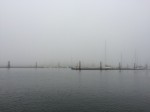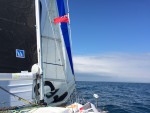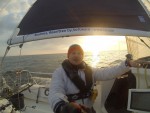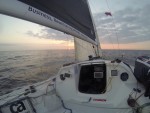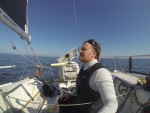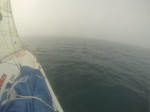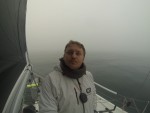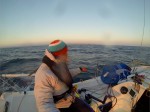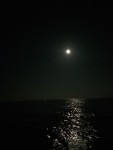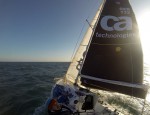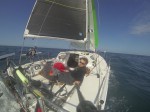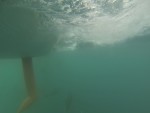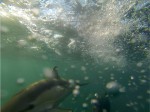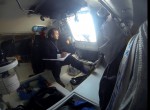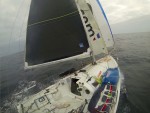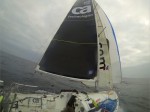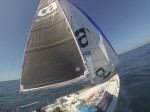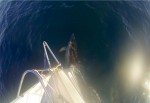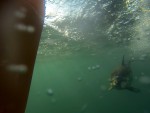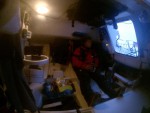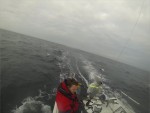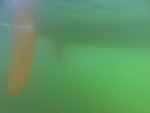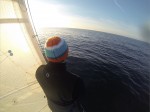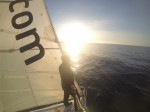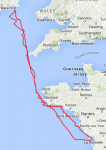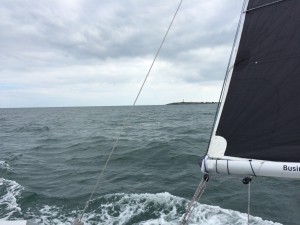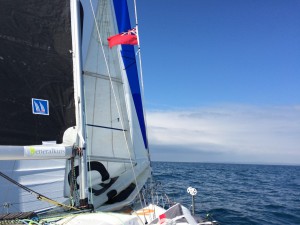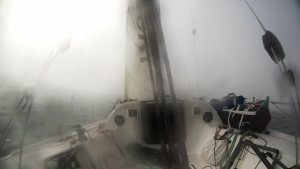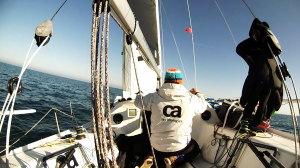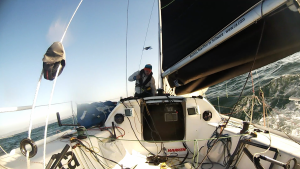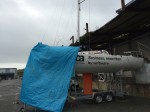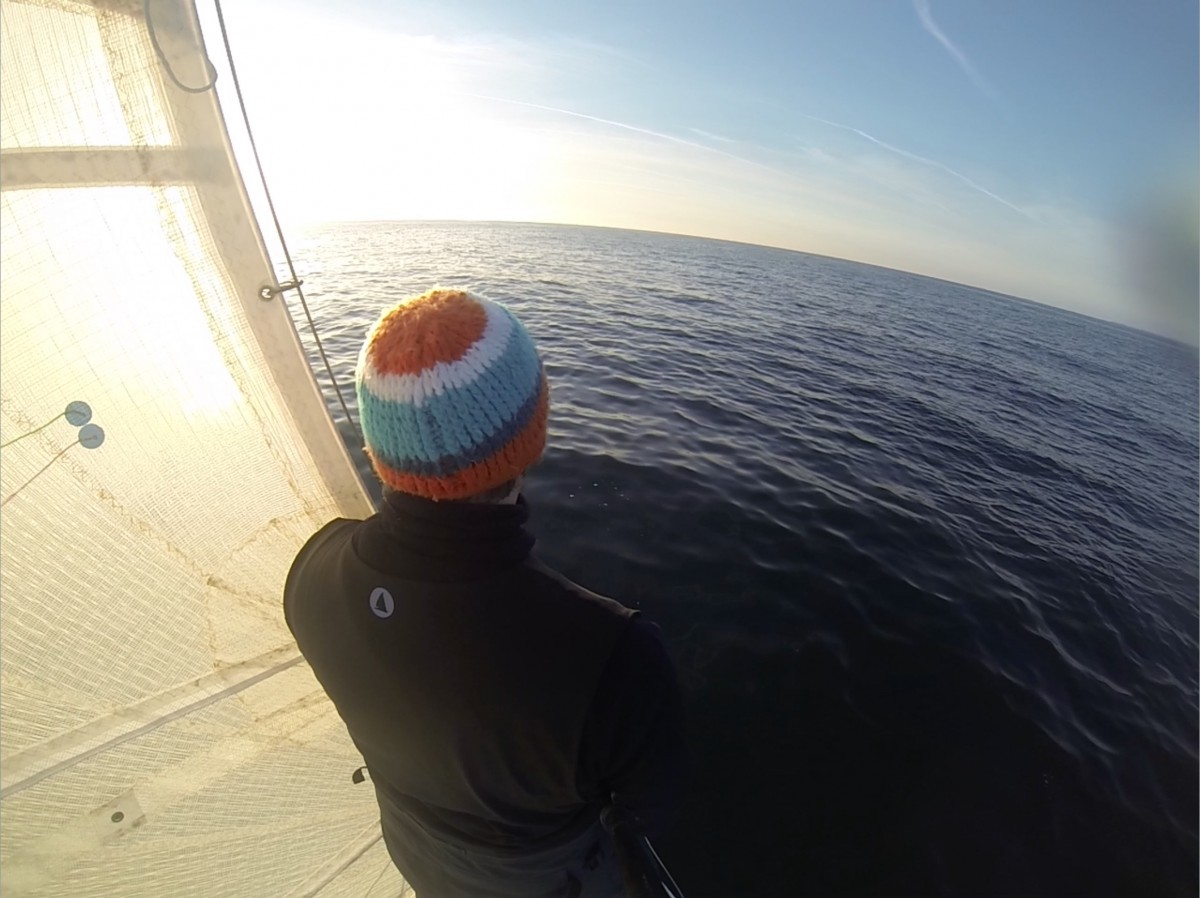
1000nm Qualifier – Part 2
It’s friday morning, we rounded Pt. de Raz at 1am against the current and now the wind blows directly from the Point de Penmarc’h, the southern edge of the Bay de Audierne and obviously our next mark. After a short leg towards Audierne the fatigue kicks in and I tack towards the open sea to get some rest. The autopilot is in apparent wind mode (which is great for speed upwind) but unhappily the wind makes a 30 degree shift and the pilot diligently follows it. When I get up from my nap we are heading northwest (instead of southeast), grrrr….
As the sun comes up we round the Point de Penmarc’h and the wind turns back and decreases in strength. My next waypoint would now be the Plateau de Rochebonne offshore of La Rochelle but my tacking angle is so poor in the light winds with remaining swell that I opt for the inshore tack instead which brings me close to the coast and the Îles de Glénan. So close to shore I can use my cellphone to pick up a weather forecast which forecasts 20-25 knots from southwest, veering south. This doesn’t sound too bad, at least the southwest bit as it would mean a tight reach, so I tack offshore and head for the Plateau de Rochebonne, some 150nm away.
I am keeping a bit right of the line to have some buffer should the wind turn south earlier than expected to reduce the amount of beating upwind I’d have to do.
At dawn the wind picks up but stays on SW and as the sun comes up again we round the first markers of the Plateau de Rochebonne at 6am – some 4 hours earlier than my routing predicted. What a quick night that was only briefly interrupted my some cargo vessels but otherwise meant a lot of sleep for me.
After rounding the SW buoy of the Plateau de Rochebonne I can bear away, hoist the medium spi and am treated to absolutely dream conditions: sunshine, 16-20kn Wind from SW slowly turning S. We are making 10 knots surfing along the southern coast of the Île de Ré towards La Rochelle.
One spi gybe and we approach the large bridge that connects La Rochelle and the Île de Ré when I get a bit cocky and keep the spinnaker up going under the bridge. A mistake cause on the northern side of the bridge a channel-effect causes 20 knots to blow from the west but after a bit hectic drop some 5m behind the bridge we are on the road again going upwind towards the northwest and Les Sables d’Olonne.
This has been the last official waypoint of my qualification and I am in good spirits: only 100nm left!
The Île de Ré disappears in the dusk and I can hoist the Code 5, then quickly switch to the big kite and we are cruising north doing 5 knots, me already calculating my ETA in Lorient.
Around Les Sables d’Olonne I have some close encounters with fishing vessels (a bit too close for comfort) but after 2 hours I finally have the sea back to myself and am trucking along with the big Spinnaker as the wind starts to drop. At 11pm I end up in a total calm (again!) some 20nm south of the Île d’Yeu. I am going to spend the night below deck sleeping on my big spinnaker with the alarm clock waking me up every 30 minutes to check for wind.
But it is going to be a long night: a 7 am we finally get steady 1-2 knots of wind and off we go again.
Not long after we can hoist the big spinnaker again and have great sailing: 12-15kn of wind propel us with 6-7 knots towards Belle Île and we can easily avoid the cargo traffic around St. Nazaire.
Early afternoon, we are able to lay Lorient, the sun is shining and I open my final good food thinking we’ll be home soon as the calm hits us once again. It will be another couple of nerve-wrecking ours of drifting south of Belle Île with no wind whatsoever, no clouds and Lorient so close I could smell it. I spend the time ranting into my GoPro camera and considering other hobbies.
In the early evening we finally get some wind again, of course it blows directly from Lorient: So a final couple of hours beating upwind in a freezing wind until we arrive at the dock in Lorient at 6am on Monday morning – 8 days and 17 hours after setting off.
Here are some pictures from the qualifier. Some photos are stills from videos where I talk which might explain the funny faces.
- LandsEnd
- Sonnenuntergang / Sunset
- Sonnenuntergang in der irischen See / Sunset in the irish sea
- Seenebel auf dem Weg nach Irland
- kurz vor Coningbeg, irische Küste
- Spinnaker setzen / Hoisting the spinnaker
- Nachmittags / Afternoon
- Der Nebel ist vorbei!!! / No more fog!!!
- schon wieder Nebel / Fog… again
- Fog / Nebel / Brouillard
- Reffen vor Land’s End / Reefing the Sails while rounding Land’s End
- Land’s End im Abend / Rounding Land’s End at sunset
- Vollmond
- Schlafen an Deck / Sleeping on deck
- Mit Autopilot am Wind / Upwind with the pilot
- Two-Sail Reaching
- Code5 Reaching
- Delfine zu Besuch / Visiting dolphins
- Delfine zu Besuch / Visiting dolphins
- Logbuch schreiben / Keeping the logbook
- Code 5 bergen / Dropping the Code 5
- Mit Medium Spi auf dem Weg nach La Rochelle / On the way to La Rochelle with medium kite
- Mit Medium Spi auf dem Weg nach La Rochelle / On the way to La Rochelle with medium kite
- Downwind with Medium Spinnaker
- Spi Halse / Gybing the Spinnaker
- La Rochelle / Île de Ré
- Delfine zu Besuch / Visiting dolphins
- Delfine zu Besuch / Visiting dolphins
- Frühstück unter Deck / Breakfast below deck
- Speeeeeeeeeed
- Ruderblätter-Kontrolle / Checking the rudders for seaweed
- Sonnenuntergang bei Belle-Île / Sunset at Belle-Île
- Sonnenuntergang bei Belle-Île / Sunset at Belle-Île
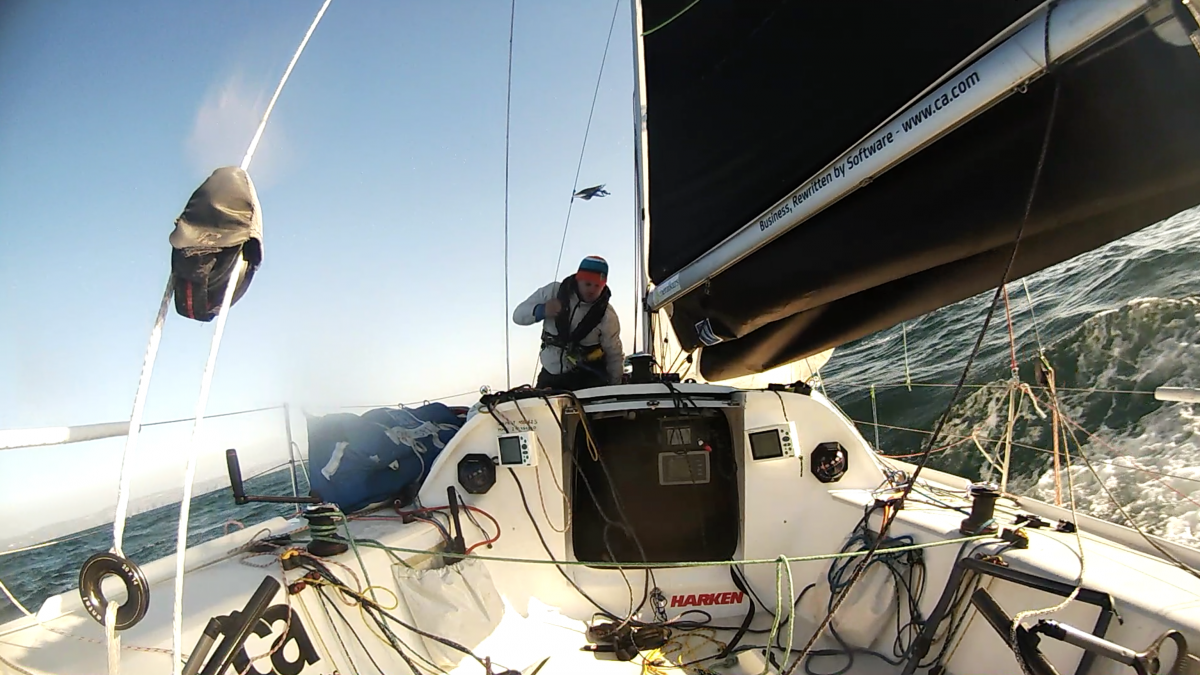
1000nm Qualifier – Part 1
Almost two weeks have passed and I finally find the time to do a write up on my 1000nm qualification course.Ever since last fall my plan was to do my qualifier as early in the year as possible so all preparations were pretty much finished and the boat packed up since end of january. It would take another two months until the stars would finally align and I would find both a nice weather window for at least 4-5 days and my job would allow me to take a week off.
Saturday, April 4th I decided to sleep in and have a relaxed breakfast, then I did some final grocery shopping and cleaned up the boat.
After the harbormaster in Lorient had stamped by logbook, Nicolas d’Estais pushed me from the dock and we were on the road. On the way out I met a couple of minis doing training, then I headed west towards the Îles de Glénan. With full main and solent at first the wind veered further towards southwest and soon I was making good progress with the medium spi, enjoying the sunshine.
On came the power and we passed the Pt. de Raz at slackwater at around 12pm on Saturday night. This must have been the most relaxed time I have passed this cape which tends to make a rounding stressful with currents of 4 knots and plenty of waves.
Once I was clear of the Île de Tevennec (right north of Pt. de Raz) at around 3am I dropped the spinnaker and put a reef in. The wind was turning more westerly again and had picked up to 14-18 knots. On a tight reach with no boats in sight or on the AIS I went downstairs for a couple of naps.
Right in the middle of one nap I wake up as the boat seems to feel different so I want to go on deck to check if everything is alright as I notice the GPS indicating a speed over ground of 13 knots (that is pretty quick!). I jump on deck but everything is fine, the wind has picked up to a steady 20 knots with gusts of 27 so I put another reef into the main and we are cruising with a comfortable 8kn, the pilot steering – me sleeping, across the English Channel.
Sunday morning the wind drops down and we can hoist the big spinnaker again, still doing a comfortable 6 knots directly towards Land’s End which we round around lunchtime in the sunshine.
In the first 24 hours we log 161nm, an average of 6.7 knots, not too shabby considering I was in “cruising mode”.
The result are fickle, heavily veering winds of 2-3 knots that slow our progress down significantly for the rest of Easter Sunday. At night the wind finally dies down entirely, we have 1-2 knots of wind with a remaining swell. And to make things even worse a dense fog with a visibility of about 150 meters surrounds us. It is freezing cold so I spend a lot of time below deck and it’s not like I can see a lot upstairs anyways. I keep an eye on the AIS and my radar warner and try to avoid looking at the GPS: The next waypoint, the lighthouse “Coningbeg” is not coming closer.
Result of the second day: 55nm, an average of 2 knots. No Comment.
Finally, at Tuesday morning around 4am we finally get a little wind and as the sun comes out the fog disappears. We are tacking upwind in the sunshine, everything is on deck to dry out and we get a lift and are able to lay Coningbeg. Life is starting to be fun again!
We round Coningbeg, make the obligatory photos of the mark and myself, then up goes the big spinnaker for the way back south. To celebrate the occasion I open one of my two beers on board and treat myself to some crackers and ham, then a nap below deck.
This time it will take me 30 hours with fickle winds, about 9 hours absolute calm and a lot of swearing before I see the coast of cornwall appear at the horizon on thursday morning. The closer we come to Land’s End this time, the wind increases and I put a reef into the main, then a reef into the solent, then another reef into the main, beating against the force 7 easterly winds (25 knots with gusts of low 30s).
After rounding Land’s End with the last sunlight on thursday night it turns out this was not a cape effect so we continue our way onto the channel. First beating, then happily the wind turns slightly to the north allowing us a two-sail reach towards Ushant doing 6-7 knots.
Cargo traffic is heavy this time: we have to dodge a couple of ships and I spend some time on the VHF with “Ushant Traffic” and the Cargos themselves to find a safe route through this heavily frequented waterway.
Friday around lunchtime we pass Ushant with the Code 5 doing 5-7 knots and although it is freezing cold we have something to celebrate: the first 500 miles are behind us. My ETA at Point de Raz looks perfect until the wind decides to rain on the parade by disappearing completely again.
For the next six (!!!!) hours we drift towards the rocks south of Ushant before a new wind sets in from the south.
Within minutes it goes from dead calm to 18, then 25 knots of wind and we go back to 2nd reef in the main and one reef in the solent, beating upwind.
Night falls and I decide that although we are going to be late for the tide, I will try to go through Point de Raz (rather than go outside around île de Sein which is a detour of 11nm).
Things get a bit interesting as during my final tack in front of the La Plate lighthouse the shackle on the solent tack breaks, we crash-tack and with the main sail blocked by the backstay we drag the leeward lifelines through the water in the pitch black.
Again some swearing, then I shake out the reef in the solent, sort out the mess and off we go again.
At 1pm on friday morning we are finally south of the Point de Raz and return to the bay of Audierne, still beating upwind.
(to be continued…)

Ch… Ch… Ch… Changes – Mini 6.50 bows over time
After Structures presented the new Pogo3 at the Boot Duesseldorf the scow-like bow is topic for discussion in various sailing media (although by far not the first appearance if you take e.g. the MACIF Open 60 into account which won the last Vendee Globe in 2012).
During training with Lorient Grand Large last october/november I had the pleasure of training against almost all of the latest three generations of Mini 6.50 series boats including the Pogo3 (white hull without a number).
After training I took advantage of the situation and took photos of all of the series boats and two protos (754 from 2009) and the latest proto #865 from 2014.
When you compare the photos it is interesting to see the deck rise (the green pogo1 having a pretty flat deck, no rise towards the bow) and then see the volume coming down and forward.
The alleged speed advantage of 0.5 knots upwind (which is being quoted a lot when talking about the Pogo3) has not been visible during training with any of the new designs, so far all of the generations were keeping up quite well in the various conditions we encountered from 3kn to 28kn and 3m waves.
But I suppose it’s just a matter of time until the sailors figure out all the tweaks and are able to use the full potential of the latest generation boats. Especially during the video debrief of our training sessions it became obvious that the mast trim of the Pogo3s was not optimal yet and they are also still experimenting with different sails and keels.
It will be very interesting to see how quickly the sailors will come to grips with the stacking/weight trim and the boats are fully commissioned for racing.
The advantages of the new hulls are immediately visible in reaching conditions with the medium kite or Code5 where they clearly develop more power and stability than the older designs. And even in very light winds the new designs don’t seem to be handicapped: I guess it’s true that the Pogo2 and Pogo3 have the same wetted surface.
The final thing to see is whether the new designs will have teething problems (like the rudder fittings that were trouble for the Pogo2 and Nacira models initially) or whether they will claim the podium immediately. The Argo and RG650 now have their teething phase behind them and should be strong competitors as well.
We’ll know more in April when the first longer races of the season start.
Season’s endings
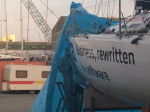 In November the boat underwent a small refit-session. During training in October there was a misunderstanding with the Pogo2 514 during a tacking duel, they took our priorty and we T-boned them. Luckily for the 514 we hit the hull/deck joint so they remained unharmed, we however took quite a hit under the forestay, also the metal “V” that is used to unfold the bowsprit was ripped off.
In November the boat underwent a small refit-session. During training in October there was a misunderstanding with the Pogo2 514 during a tacking duel, they took our priorty and we T-boned them. Luckily for the 514 we hit the hull/deck joint so they remained unharmed, we however took quite a hit under the forestay, also the metal “V” that is used to unfold the bowsprit was ripped off.
While Younn took care of the gelcoat- and underlying laminate-damage I took care of some other things on board:
– sanded the rudders and applied new gelcoat
– new tillers adapted to the rudders, drilled and installed
– repaired the solent-light (soo cool when trimming at night, also awesome to be seen by fishing vessels)
– re-waterproofed the mast where it leads through the deck
– re-waterproofed the pushpit & stanchions
– re-waterproofed the engine mount at the transom
– small service on the fuel cell
– changed the speakers in the cockpit (again proper music!)
During the week I also kept the dehumidifier and heater running and completely cleaned and dried the boat on the inside.
Around 5pm on friday Younn & me worked hectically – kindly supported by Erwarn – to finish the installation of the pushpit and the forestay fitting to get the boat back into the water before 6pm 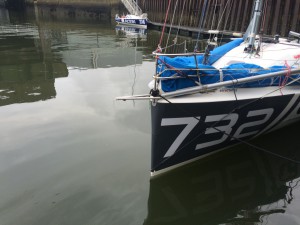 .
.
Saturday morning I started getting the boat ready for training but a look around already indicated bad news: thick fog (visibility 200m?) and no wind whatsoever.
To make the best of it, we did a “mast trim day” and measured all boat’s stay tensions and prebend, then did a long theory session in the meeting room to discuss mast trim, sail combinations for the transat and a deep-dive into pilot settings.
That was it for this year – the boat is now in hibernation for about end of january when training will resume.
